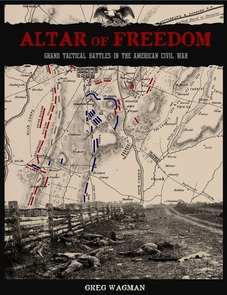 |
| It's "The Mild Bunch" circa 1977. |
 |
| Nice cover art work too |
The rules a short, crisp and have the minimum of modifiers to combat. The core of the game is the activation bidding system. Each player has Army and Divisional commanders represented on the table. These all have command points available plus some traits that may impact how they can allocate those points, along with some which impact on other things such as combat. At the start of the turn those points are allocated between divisions to determine the sequence of activation. Highest bids go first. Points can only be applied to units in that general's chain of command. Some points can be held back to be used in the admin phase at the end of the turn (where reserves can be moved and units may attempt to rally amongst other things. The other important use of these points is to gain control of the turn clock. The turn clock has a value ( determined by the scenario) after each group of divisions on the same bid value have moved and fought both players throw a dice and the player who controls the clock decides which one to use. The value on the chosen dice is deducted from the turn clock and then the next set of divisions are moved at the end of those divisions turns the players throw the dice again to count down the turn clock. Once the turn clock passes zero the turn ends. So by having control of the turn clock a player who needs to do a lot in a turn can choose the lowest dice rolls and delay the end of the turn or if they want to block the oppositions plans they choose the higher dice rolls. this can be useful if there are a lot of reserves needing to be brought up or broken units to rally. Although its a bit 'gamey' it does allow the impact of generalship to be modelled. The traits assigned to generals reflect their performance on the day of the battle so as army commander the player has to deal with the personalities. This is something I really like.
The units are generic brigades on standard bases which makes creating the units easy. They have a numerical modifier to reflect larger or smaller formations or a better or worse performance at a particular engagement allocated for each battle.
The scenarios cover the major battles of the war with a tablelayout, order of battle and specific traits for the relevant commanders for that battle. These vary from battle to battle to reflect how they behaved on that specific day.
Of course this being me a confirmed 6mm player I decided to try the rules using 2mm figures as the recommended scale for buildings is 2 mm. Plus I can make markers quickly and easily to get up and running. In due course I may use 6mm figures, or I may not!
The website for the game is excellent (a real plus in favour of the rules in fact) there are free introductory scenarios to download, a free Gettysburg campaign rule set (also free) and a select of paper building's to make (again free). These can be found here https://www.6mmacw.com/ along with the rules and other helpful advice on building terrain.
So I have a start on Brigade bases and terrain. So its "On to Richmond" next with a try out of First Manassas as soon as the rest of the units are done.
How many bases make up a brigade please?
ReplyDeleteOne base per brigade on 60 x 30mm for Infantry (which is the vast majority of units). There is no prescribed number of figures per base as there is a certain amount of bath tubing in unit sizes to make a single set of rules work across all of the major battles.
DeleteThanks. So I imagine it could be scald down to smaller bases and table-sizes too
DeleteIronically, I praised the exact same ruleset on my page today, I love the single base for a unit system
ReplyDeleteThe rules do look interesting but not solo friendly. Looking forward to how proceed with solo play.
ReplyDeleteI'm thinking that I ascribe a priority level to divisions on the AI side. I then use the random number generator to mix up the bids subject to min max constraints based on the priority level . I also need to come up with a way to determine bids to control the game clock and how many points to hold back for the admin phase. Leave it with me, as it were.
DeleteGood choice! It's a great set of rules!!
ReplyDelete